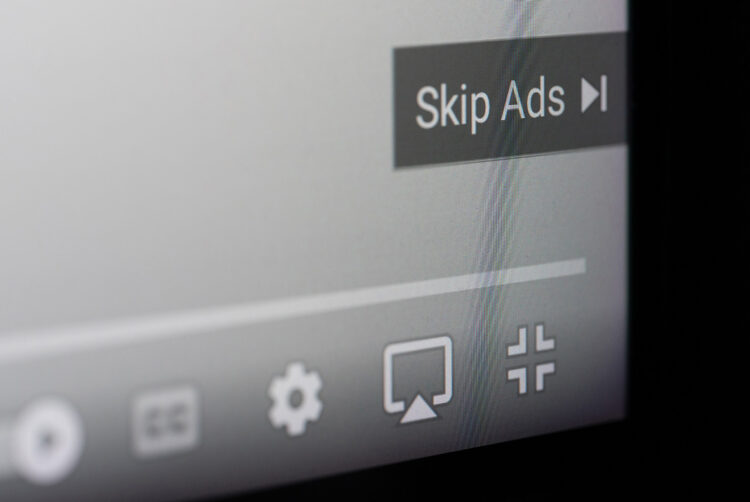YouTube at 20: Thanks for all the skips

Opinion
That small rectangle in the corner of the screen proved that advertising could work differently, viewers could have a choice and, given the option, people will engage when brands respect their time.
Last week marked a special moment in digital history, with YouTube celebrating its 20th birthday.
Two decades of talking dogs, food porn, Florida men and ASMR soap-cutting videos. Tempting as it is to use this as a cue to spend today’s lunch hour looking back at top hits like “Charlie Bit My Finger”, it’s worth recognising one of YouTube’s most radical innovations: the ad-skip button.
At first glance, it might not seem revolutionary. A small rectangle in the corner of the screen, giving you the option to bypass an ad after five seconds. But that simple function has reshaped digital advertising in ways that still ripple across the industry today.
The question that changed advertising
Before the skip button, advertising on YouTube followed the traditional model: a captive audience, forced to watch whatever brands put in front of them.
Then, in 2008, YouTube’s Shishir Mehrotra asked a question that would challenge this model entirely: “Why can’t you skip ads?”
It was not a popular idea. Advertisers and sales teams feared it would undercut revenue, with users able to skip and miss that all-important messaging. After all, if people could skip, wouldn’t they always skip?
But that fear overlooked a fundamental truth: forcing people to watch ads isn’t the same as earning their attention. Mehrotra and his team saw an opportunity to shift the equation. Instead of locking viewers in, why not challenge advertisers to make content people want to watch?
From forced attention to earned engagement
When the skip button (later known as TrueView) finally launched, it didn’t just improve the viewing experience; it forced a reckoning in the advertising world. Suddenly, brands had to ask for — instead of demanding — people’s time.
And the results proved the sceptics wrong. Advertisers that adapted to this new reality — those that focused on creativity, storytelling and relevance — didn’t just survive; they thrived. These are brands that stay true to building a human connection with viewers and spotlighting the special moments and causes their brand supplements.
Like the Asics “A New Personal Best” campaign, which got more attention while championing mental health initiatives. Asics worked with us to incentivise viewership by linking ad views to donations for mental health charities. When brands choose to earn attention using watch-to-donate formats, we’ve seen completed view rates increase dramatically, often by up to 50%.
The skip, essentially, is not guaranteed if the incentive to stay is right. YouTube’s assessment of brands that found success in 2024 focused on engaging audiences’ passions. Brands experimenting with ads to tell substantial and unique stories helped build stronger affinity with audiences.
This speaks to the legacy of the skip button, which became a filter for quality and set a new standard for digital engagement. More than just a UX feature, it was a shift in power. It proved that advertising could work differently, that viewers could have a choice and that, when given the option, people will engage when brands respect their time.
‘Fit for TV’ YouTube channels drive higher ad attention than non-premium video
Timeless lessons from an unsung hero
Yet the transition to this standard hasn’t been straightforward.
Twenty years on and it’s apparent that advertisers have struggled to meet this bar, millennials are becoming disillusioned with ads and frustrations are increasing with Gen Z , as younger audiences crave more authentic engagement.
But the approach to these warnings has been flawed. “We tried to change the advertising ecosystem by doing more ads and all that did was create more noise,” said Proctor & Gamble’s Marc Pritchard in 2019.
And the problem with this ad clutter is that it reduces voluntary engagement even further. Research shows 99% of Gen Z are willing to skip an ad if given the choice.
This has led to an increasing popularity of ad-blockers, as viewers have gone to new extremes to avoid intrusive ads. According to Statista, 46% of 25- to 34-year-olds said they use ad-blocking software. This is a pressing challenge for advertisers among younger audiences and also for social platforms like YouTube, which have ramped up efforts to combat this trend.
Media Nations: YouTube influence on the big screen grows — will TV ad budgets follow?
This makes features like the skip button the unsung hero of our industry. At a time when advertisers sought to overload, YouTube provided a way to make us work harder on creative, storytelling and targeting.
The skip button was a trailblazer because it provided a means of empowering and engaging consumers. Viewers respond to experiences and impactful content that imparts a feeling of cultural relevance rather than force-fed marketing.
And it represents a simple ultimatum for advertisers. You can showcase how you add value beyond imparting information on your product or service, entertain or tap into people’s passions — or get skipped and forgotten. Brands and consumers can play cat-and-mouse, but we’re all better off earning one another’s attention in mutually beneficial ways.
So, with YouTube now at 20, let’s take a moment to appreciate this tiny but mighty piece of the platform’s legacy.
The skip button wasn’t just an improvement; it was a revolution that redefined the relationship between brands and audiences, proving that attention isn’t something to be taken but something to be earned. And that, my friends, is an ad worth watching.
 Amy Williams is founder and CEO of Good-Loop
Amy Williams is founder and CEO of Good-Loop




